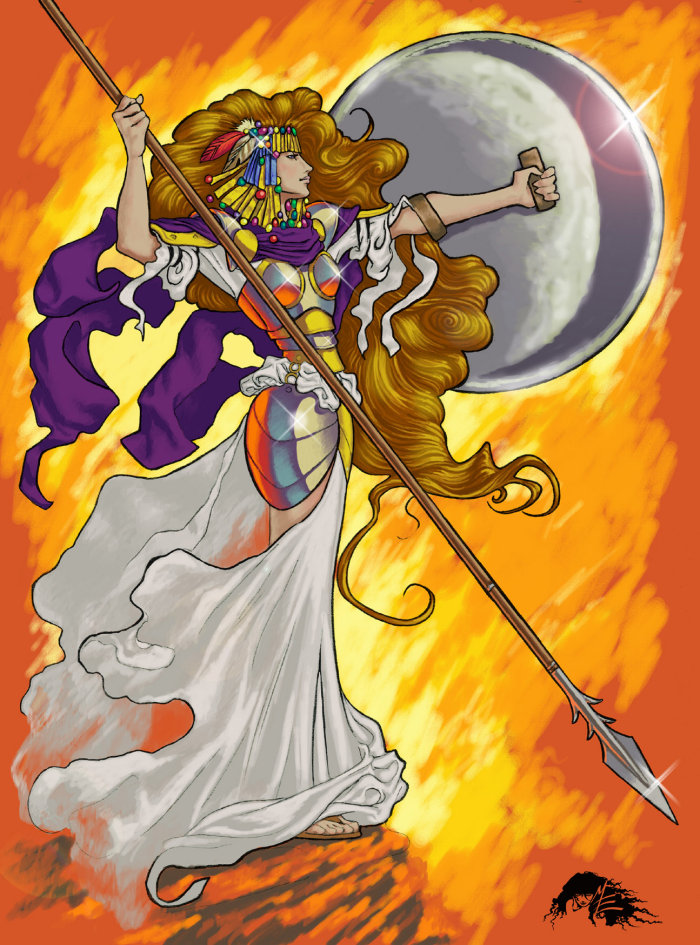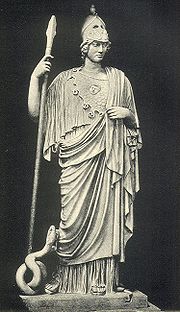|
|
|

 |
| Athene by Michael Erickson from Epilogue.net |
Athene is first and foremost the Matron Goddess of Athens, one of the most famous cities of the ancient and modern worlds. She is the divine bringer of wisdom and matroness of many crafts, which the Greeks attributed directly to Her; among these are weaving, metalworking, and pottery, which are most useful skills for anyone to have. She was also called upon by those who fought as defenders of their homes from aggressors. She is one of very few Goddesses ever depicted in any kind of armor or armed. During classical times, Athene was stated by the philosopher Plato as being identical to the Goddess Neith, who was worshipped in North Africa by the Libyans and the Egyptians since before the dynastic period. Athene's first appearance though, is in early Minoan Linear B texts where Her name is Atana Potinija. As Atana, She appears before Her supposed father, Zeus, and She was viewed by the Minoans and Pelasgian Greeks as being of an older generation of Goddesses, born parthenogenetically from Her mother, Metis, Titaness of Wisdom. Of course, this was later perverted by the Dorian Greeks to the familiar story of Zeus swallowing Metis and Athene being born from his head. Some of Her other titles include:
Nikę - Victory
Eryma - Defender
Alalkomenęis - Protectress
Polias - Of the City
Polioukhos - Protectress of the City
Paiônia - Healer
Oxyderkęs - Sharp Sighted
Parthenos - Virgin
Gigantoletis - Destroyer of Giants
Gorgolaphas - Gorgon-crested
Pronoia - Foresight
Hippia - Of the Horses
Erganę - Worker
Glaukopis - Bright Eyed
 |
The Panathenaea was a yearly festival held in Athens in honor of Athene's birthday. The festival started before dawn at the north gate of the city, where the Kanephoros, young unmarried women of the Eupatrid families, carried baskets of offerings and led the procession into the city through the Agora and eventually to the Acropolis past the temple of Athene Parthenos to the outdoor altar of Athene in front of the Erectheum. Here a new peplos, the traditional tubular dress of Greek women, was dedicated to Athene and would be placed upon Her statue upon the completion of the Plynteria festival. Every four years, the Great Panathenaea was held where along with the processions and sacrifices, a great games were held to which athletes, philosophers, and dramatists from all over the Greek world would come and compete in Her honor. On the final night of the festival the hekatomb, a sacrifice of a hundred oxen, would be done followed by the pannychis, an all night feast, which drew the festival to a close.
Classically, the most common representations of Athene bear a close resemblance to the famous statue of Her done by the celebrated sculptor Phidias for the Parthenon. This lost statue was 36 metres tall and made of gold and ivory. It disappeared in the early Christian era when Christians offended by this depiction of a Pagan Goddess removed Her from the temple. It is unknown whether the statue was destroyed or buried or simply hidden away. There is a legend of a man named Proclus, who was still a devotee of the Lady, who dreamed that the Goddess came to him and told him that She wished to dwell with him. Another depiction of Athene is the Mourning Athene, which was done in 460 BCE and shows a weary Athene resting on Her staff. Regardless of the various attributes such as Nike or an owl or armor/shield that were shown with Her, Athene is usually portrayed as having a full, strong chin, a high bridged nose, deep-set eyes, and a full, unsmiling mouth. Her expression is usually serene and contemplative.
I begin to sing of Pallas Athena, the glorious goddess,
bright-eyed, inventive, unbending of heart, pure virgin,
saviour of cities, courageous, Tritogeneia.
From his awful head wise Zeus himself bare her
arrayed in warlike arms of flashing gold,
and awe seized all the gods as they gazed.
But Athena sprang quickly from the immortal head
and stood before Zeus who holds the aegis, shaking a sharp spear:
great Olympos began to reel horribly at the might of the grey-eyed goddess,
and earth round about cried fearfully,
and the sea was moved and tossed with dark waves,
while foam burst forth suddenly:
the bright Son of Hyperion [the Sun] stopped his swift-footed horses a long while,
until the maiden Pallas Athena had stripped the heavenly armour from her immortal shoulders.
And wise Zeus was glad. Hail to you, daughter of Zeus who holds the aigis!"
 Back to the main page...
Back to the main page...